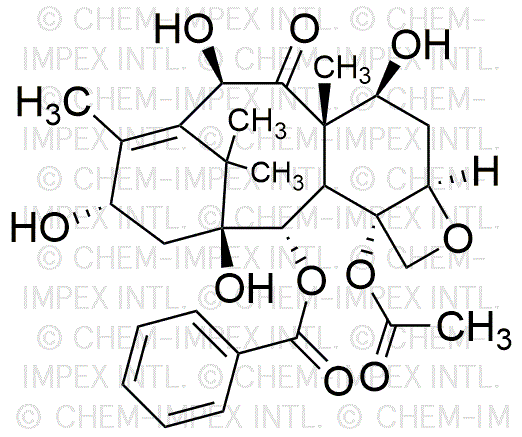10-Deacetylbaccatin III is widely utilized in research focused on:
- Pharmaceutical Development: This compound serves as a precursor in the synthesis of paclitaxel, a widely used chemotherapy drug, enhancing cancer treatment options.
- Natural Product Research: It is studied for its potential anti-cancer properties, offering insights into new therapeutic agents derived from natural sources.
- Biotechnology: Researchers explore its role in plant biotechnology, particularly in the genetic engineering of plants for improved medicinal properties.
- Cosmetic Formulations: Its antioxidant properties make it a valuable ingredient in skincare products, promoting skin health and protection against environmental stressors.
- Research on Drug Resistance: It is used in studies to understand and combat drug resistance in cancer cells, providing critical information for developing more effective treatments.
Informations générales
Propriétés
Sécurité et réglementation
Applications
10-Deacetylbaccatin III is widely utilized in research focused on:
- Pharmaceutical Development: This compound serves as a precursor in the synthesis of paclitaxel, a widely used chemotherapy drug, enhancing cancer treatment options.
- Natural Product Research: It is studied for its potential anti-cancer properties, offering insights into new therapeutic agents derived from natural sources.
- Biotechnology: Researchers explore its role in plant biotechnology, particularly in the genetic engineering of plants for improved medicinal properties.
- Cosmetic Formulations: Its antioxidant properties make it a valuable ingredient in skincare products, promoting skin health and protection against environmental stressors.
- Research on Drug Resistance: It is used in studies to understand and combat drug resistance in cancer cells, providing critical information for developing more effective treatments.
Documents
Fiches de données de sécurité (FDS)
La FDS fournit des informations de sécurité complètes sur la manipulation, le stockage et l’élimination du produit.
Spécifications du produit (PS)
Le PS fournit une description complète des propriétés du produit, notamment sa composition chimique, son état physique, sa pureté et les exigences de stockage. Il détaille également les plages de qualité acceptables et les applications prévues du produit.
Certificats d'analyse (COA)
Recherchez des certificats d'analyse (COA) en saisissant le numéro de lot du produit. Les numéros de lot et de lot se trouvent sur l'étiquette d'un produit, après les mots « Lot » ou « Lot de fabrication ».
Numéro de catalogue
Numéro de lot/série
Certificats d'origine (COO)
Ce certificat d'exploitation confirme le pays dans lequel le produit a été fabriqué, et détaille également les matériaux et composants utilisés et s'il est issu de sources naturelles, synthétiques ou autres sources spécifiques. Ce certificat peut être requis pour les douanes, le commerce et la conformité réglementaire.
Numéro de catalogue
Numéro de lot/série
Fiches de données de sécurité (FDS)
La FDS fournit des informations de sécurité complètes sur la manipulation, le stockage et l’élimination du produit.
DownloadSpécifications du produit (PS)
Le PS fournit une description complète des propriétés du produit, notamment sa composition chimique, son état physique, sa pureté et les exigences de stockage. Il détaille également les plages de qualité acceptables et les applications prévues du produit.
DownloadCertificats d'analyse (COA)
Recherchez des certificats d'analyse (COA) en saisissant le numéro de lot du produit. Les numéros de lot et de lot se trouvent sur l'étiquette d'un produit, après les mots « Lot » ou « Lot de fabrication ».
Numéro de catalogue
Numéro de lot/série
Certificats d'origine (COO)
Ce certificat d'exploitation confirme le pays dans lequel le produit a été fabriqué, et détaille également les matériaux et composants utilisés et s'il est issu de sources naturelles, synthétiques ou autres sources spécifiques. Ce certificat peut être requis pour les douanes, le commerce et la conformité réglementaire.


